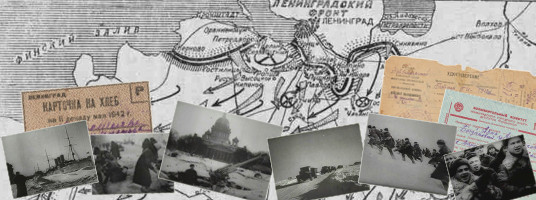Defence and Siege of Leningrad

The collection was created in 2014 to commemorate the 70th anniversary of the complete liberation of Leningrad from Nazi occupation. It contains a vast array of various sources, including official documents, newspapers, cards, flyers, memos, periodicals, postcards, photographs, and newsreels. Electronic copies of materials from personal archives of St. Petersburg citizens are particularly valuable to the collection. These include photos, certificates, interviews, drawings, and personal records of citizens during the siege. In November 2018, the Presidential Library launched a major project to collect and digitize family archives related to the city's siege.
Siege memoirs, diaries, and letters are not only a reflection of the lives of Leningrad residents during the war but also a valuable source of information about the history of the city. They provide us with a unique insight into the experiences, feelings, and struggles of those who lived through the siege. For example, Nadezhda Proskurina's memoirs describe in detail her experiences as she worked on the construction of trenches and harvested firewood during the siege. She describes the pain of losing her family and the unbearable hunger and fear that she felt. These accounts also reveal the grim realities of life in the city during the siege, such as the use of carpenter's glue as a substitute for food and the common practice of burying the dead in mass graves.
A separate part of this section is dedicated to childhood memories from witnesses of the Siege of Leningrad. One of these memories belongs to Alice Vishnyakova, a child during the blockade. In her memoirs, she expresses her gratitude to the educators at Kindergarten No. 7, the employees of the Kozitsky factory, and all those who helped her through those difficult years.
Another undoubtedly important source for studying the siege of Leningrad during the catastrophic shortage and famine is the ration cards that were introduced in the city in the first months of the war. These cards belonged to Tamara Alexandrovna Korosteleva, who survived the blockade and later became a prominent biologist. In December 1942, Tamara Alexandrovna shared her rations with children from a communal apartment on the eve of the New Year, treating them with sugar and millet porridge. These cards not only provide historical evidence of the hardships of the blockade but also serve as a reminder of the kindness and generosity shown by those who lived through it despite the inhuman conditions.
During the worst winter siege of 1941-1942, the city of Leningrad, now Saint Petersburg, was facing an unprecedented challenge. With food supplies dwindling, the city turned to new sources for survival. A number of brochures and publications were produced to help residents navigate the difficult times.
One such publication was a brochure titled The Use of Wild Edible Plants for Food, published by the Main Directorate of Leningrad's canteens, restaurants, and cafes under the People's Commissariat of Trade. This brochure provided information on how to identify and prepare various wild plants for consumption, such as nettles, sorrel, and swan plants. Recipes were included, along with instructions on how to harvest and preserve these plants for future use.
Another publication, The Use of Garden Plant Tops for Food and Harvesting It for the Future, was also published by this organization. This brochure focused on the use of plant tops, such as nettles and sorrel, quinoa, capsella for food. Recipes and guidelines were provided, as well as information on how to safely harvest these plants and prepare them for consumption.
These publications, along with other measures taken by the city, helped Leningraders survive the difficult winter months. One significant measure was the organization of subsidiary farms, which provided the population with additional plant-based food. The cultivation of vegetables was seen as essential, even being compared to the production of weapons. In the memos, residents of Leningrad were urged to grow crops in their gardens (Every resident of Leningrad should consider it their civic duty to grow vegetables for themselves and their families in their personal gardens...). By the summer of 1942, nearly 10,000 hectares of land had been plowed for vegetable growing in the city, and 633 subsidiary farms were organized.
The collection also includes a large amount of illustrative material, such as TASS photo chronicles, a series of postcards titled "Leningrad During the Great Patriotic War," newsreels titled "Defence of Leningrad," video lectures from the educational project "Knowledge of Russia," and a series of television programs called "Diary of the Siege."
The Siege of Leningrad is a significant event in our history that must be remembered and studied in order to prevent similar tragedies from happening again. The materials in this collection provide historical evidence that we must preserve to honor the heroism and resilience of the people of Leningrad during this difficult time.




